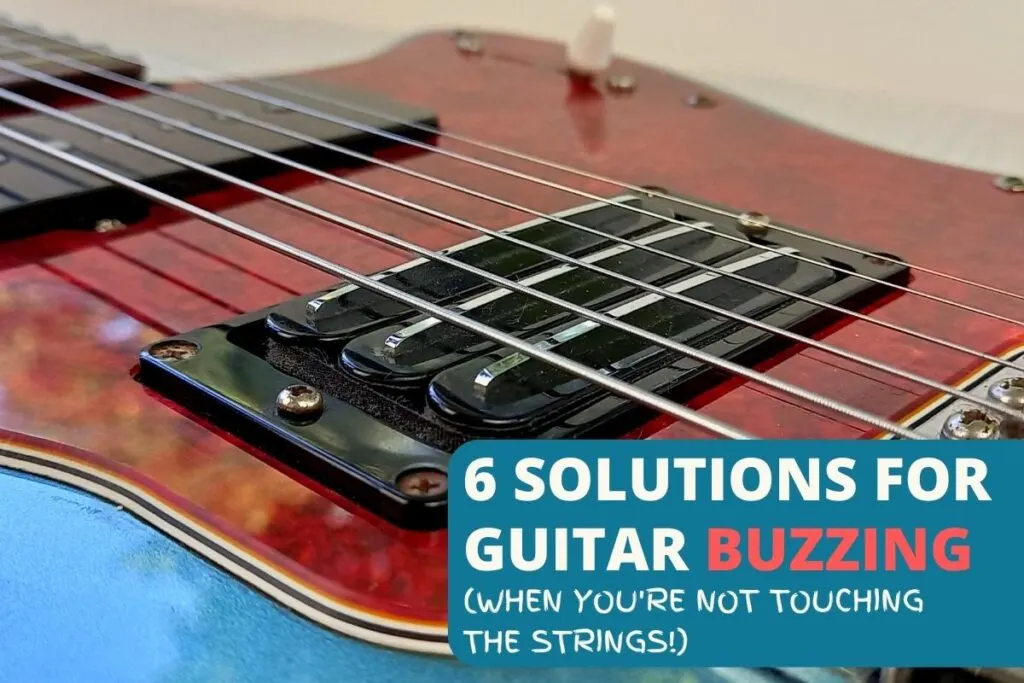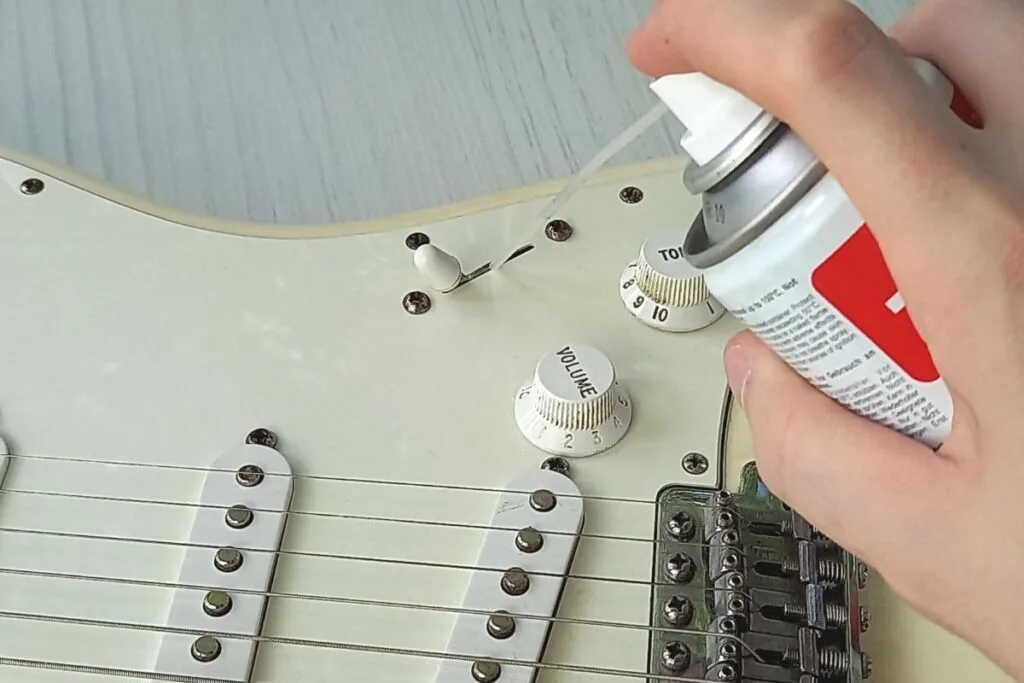Guitars are meant to make noise, but unfortunately, sometimes buzzing is one of them. Many guitarists, myself included, have faced the issue of a buzzing noise coming from the guitar when it’s plugged in without touching the strings. But, what causes this, and what can you do to fix it?
The most common cause of a buzzing noise in a guitar is a grounding issue in the guitar, its components, the cable, or the amp. However, it could also indicate faulty or dirty pickups or other electronics, as well as interference or feedback. Background noise is also typical for single-coil pickups.
Luckily for you, it’s pretty easy to sort through the list of possibilities and find the actual culprit. Once you know what’s causing it, it’s usually relatively easy and cheap fix. So, let’s look at all of the possible causes and see how you can stop that humming!
Cause 1: Grounding issues
The most common and frequent cause of humming noises from a guitar is a grounding issue. It’s usually pretty easy to identify if this is the cause. The challenge is that there can be a few different components that have the grounding issue. So, it’s important to figure out which one it is!
Common signs of grounding issues
Grounding problems, apart from causing a humming noise, usually have a few other signs that go along with them. This makes them easy to identify.
Usually, if your guitar makes a humming noise that stops when you touch the strings or any metallic part of your guitar (especially if you’re barefoot), it’s a tell-tale sign that grounding is the problem. The noise stops because you’re touching a metal part, which means that you are effectively grounding the guitar.

The humming noise could also be accompanied by frequent popping sounds, usually at regular intervals every few seconds. Sometimes the humming will stop when a pop happens, then gradually build up again until the next pop.
All of these are signs of grounding issues. The challenge is that there are many components that could be poorly grounded.
Try a different guitar cable
This is often the easiest thing to check. You’ll get a humming noise if the grounding wire of your cable is broken. Simply swap the cable around for another one. If the noise is gone, you know that was the cause.
Luckily, it’s usually easy to repair the broken cable, too, since the problem often occurs in the spot where the wires are soldered onto one of the connectors. Here’s a guide on how you can repair it yourself.
Check your amp
Amps are complex electronic devices, and often the grounding wire inside the amp can come loose, especially if you travel with it a lot. This will create a buzzing noise. If you can, try to use another amp that you know works. Any good guitar shop will let you test your guitar on one of their amps if you don’t have an extra amp handy.
If the grounding problem is with your amp, you’ll need to take it to a professional to fix. Amps can store a lot of power in them, even when they’re not plugged in, so it’s best to leave any tinkering to someone who knows what to touch (and what to not!)
Try another power outlet
Another common problem, usually in older homes, is with the power outlet itself. 9 times out of 10, it’ll be something else, but if the noise stops when you plug your amp into another outlet, especially one on another circuit, then it’s likely a problem with your wiring.
If you can, take the amp to a friend’s house if you’re unsure. If the humming noise stops and you change nothing else, then it’s probably time to call an electrician. Grounding issues in power outlets are hazardous, and not just to your sound quality!
Check your pedals
Any pedals you use, including the power supplies you use to power them, are all potential suspects. For example, daisy-chaining a power supply across multiple pedals could easily be the cause of the grounding issue.
Try plugging your guitar directly into your amplifier’s clean channel to see if the humming is still there. Then, you can try introducing one pedal at a time to find the problem pedal.

To see if it’s your power supply that’s the problem, try running your pedals off batteries and seeing if you still get the hum. If the problem is your power supply, I recommend finding an alternative.
I use the Voodoo Lab Pedal Power 2+ for this very reason. It has an isolated power supply for each pedal, so I no longer have the problem of noisy pedals. If you’re interested, you can check it out here on Amazon.
Your guitar’s grounding wires
Your guitar has wires inside it that connects all the metal parts together to ground them. If this becomes broken or damaged, you’ll get buzzing! Luckily, some guitars have an easy-access panel that you can open to check all the electronics. Open that up and follow the black wire since this is the wire used to ground the electronics. Check that it’s adequately connected at each end to ensure that your guitar is properly grounded.
Unfortunately, for guitars like the Fender Stratocaster, it’s a bit trickier: you’ll need to take off the pickguard to access the volume and tone pots, which also means removing your strings. Still, it’s worth it to get rid of that annoying hum.

I have a second-hand bass guitar that used to make a horrible buzzing noise. When I opened it up, I found that the grounding wire had become detached from one of the metal pots. After a quick solder (literally 2 minutes), I’ve never had a problem with it again!
Cause 2: Interference and lack of shielding
Many of us have been alive for long enough to remember the noise that many speakers made when you brought an old cellular phone next to them and the phone was about to ring. Beepity-beepity-beepity. That noise was caused by electromagnetic interference (EMI).
Modern speakers and electronics, including your guitar equipment, are shielded against that to some extent, but it could still cause a hum. It isn’t caused only by phones, either. There are devices all around us that emit radio frequencies, like your Wi-Fi router. Sometimes these frequencies can resonate with some components in your guitar or amp and cause a humming noise.
The best solution to the problem is to shield your guitar manually. This isn’t quick or necessarily easy to do, and it’s possible that something might break in the process. So, you may prefer to take your guitar to a luthier for a professional touch.
If you’ve confident enough to try and do it yourself, that is also possible.
The easiest way is to apply copper tape to the inside of the electronics cavities, like the holes that your pickups fit into. It’s a pretty straightforward job, you’ll just need some tools like a digital multimeter. Here’s a link to the one that I use on Amazon.
Here’s a great article from Guitar.com with step-by-step instructions on how to shield your guitar.
Cause 3: Single-coil pickups
Cause number three is not so much a problem as a side-effect. Single-coil pickups are susceptible to humming, as the coil can pick up EMI. I’ve written about it in detail in my article on single-coil vs humbucker pickups.
Essentially, humbucker pickups use two coils to effectively remove the hum from background electronic interference, but single-coils don’t have such protection.

In some ways, the background noise has become part of the characteristic sound that single-coil guitars have. Still, I use mostly single-coil guitars, and I find it annoying. So, here’s four things you can try to reduce the noise:
- Turn off or move away from any electronic devices (e.g. computers, lamps, lights, etc)
- Shield your pickups. This process is identical to the instructions in the section above.
- Get a pedal designed to eliminate the hum (either a “noise gate” or a “hum eliminator pedal”).
- Replace your pickups with more expensive noise reduction pickups. G&L (Leo Fender’s other guitar company) make single-coil pickups that have all the twang and brightness you’d expect from a single-coil, but without the hum.
Of the four options, the first and second options are probably the best in terms of simplicity and effectiveness. Option three is okay, but it doesn’t fix the root-cause. Option four is great, but can be expensive and will change the sound of your guitar.
Cause 4: Damaged pickups
Pickups are sensitive electronic devices. In most cases, they’ll last decades without any problem. But, any damage to the delicate insides can cause problems that may render a pickup useless. A damaged pickup may cause strange noises, including a background hum when you’re not touching the strings.
When your guitar starts to hum, flip the pickup selector switch to another pickup. If the noise stops, you know that the problem lies with the pickup that you just disabled, especially if it starts again when you switch it back on.
Depending on the damage, it may be that your pickup can be repaired. I’d always recommend getting a professional opinion. If it can’t be fixed, then you’ll need to get it replaced.
Cause 5: Dirt or dust in the electronics
Most guitarists try to keep their guitars as clean as possible. It’s a good habit to give your guitar a good cleaning whenever you replace the strings. But even if you do that regularly, some dust could still get into the electronics, especially if you’re not taking the proper steps to store it.
This dust often creates stray electrical signals and short circuits in the electronics, causing background noises like hums and pops.
The number one place to find this dust is inside your guitar’s pots and switches. Dust gets in there quickly because the pots are so exposed to the elements (and dirty fingers!). They also have very sensitive circuitry, so even the slightest bit of dust can cause problems.

Luckily, they’re also really easy to clean. You simply spray some contact cleaner into the pots or switches, and turn them up and down to clean them. I’d recommend picking up some of this WD-40 Contact Cleaner (from Amazon).
The output jack is another common problem area. Not only is it open to dust and grime, but oxidation also forms on and inside the jack. Again, give it a clean with some contact cleaner. If it’s too damaged, they’re really easy to replace. Here’s a quick step-by-step guide.
Cause 6: Feedback
This may seem obvious, but feedback from too much volume is also a common cause of humming noises. Remember, background noise is almost guaranteed, even if it’s just a little.
The more you amplify your guitar’s volume, the more that background noise will be amplified with it. So, when you’re not playing, the only thing it can amplify is the humming from the feedback.
Try turning the volume down a bit, both on your guitar and the amp, and see if that solves the problem. If you can still get a loud, clear signal, then it may be that your amp is just too loud.
Conclusion
There are plenty of reasons why a guitar could make a humming noise when you’re not playing or even touching the strings. A slight hum is usually not the end of the world, but it could indicate a more critical problem.
Now you know how to identify the cause and a few things you can do to fix it, so you can clean up your guitar’s sound and start rocking out with a clearer tone!

Conor is a music producer, multi-instrumentalist, and all-round enthusiast from the UK with over 15 years of experience. He’s the founder and sole-content creator for the roundtable audio blog and YouTube channel.
